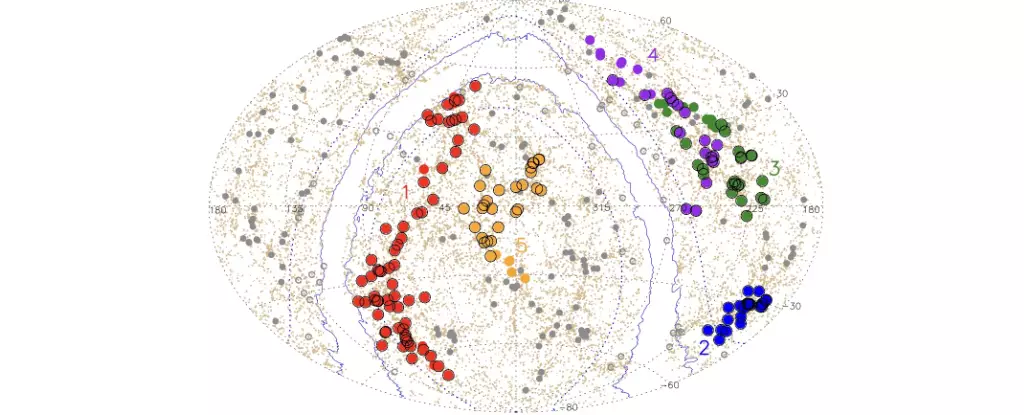In attempting to comprehend the vast cosmos, it’s essential to recognize that the immense structures within it hold pivotal insights into its evolution and essence. The cosmic landscape is inhabited by remarkable formations, one of which recently captured the attention of astronomers: the Quipu superstructure. This colossal formation boasts a staggering mass of approximately 200 quadrillion solar masses, making it a significant player in cosmological studies. Understanding such colossal structures is not merely an academic exercise; it shapes our entire conceptualization of how the Universe functions.
The grandeur of Quipu stretches beyond its sheer mass; it extends over an astounding 400 megaparsecs, or more than 1.3 billion light-years. Such extraordinary dimensions prompt questions regarding their gravitational influence on the cosmos surrounding them, drawing scientists into a deeper inquiry regarding the intricate balance of forces that govern galactic evolution.
A new research effort, encapsulated in the publication titled “Unveiling the largest structures in the nearby Universe: Discovery of the Quipu superstructure,” published in Astronomy and Astrophysics, spearheaded by Hans Bohringer from the Max Planck Institute, highlights our growing understanding of superstructures. The document elucidates how superstructures comprise numerous galaxy clusters, which collectively challenge existing cosmological models. This investigation isn’t merely about mapping structures but also about decoding how these clusters influence the evolution of galaxies themselves.
By scrutinizing Quipu and its counterparts, researchers can refine cosmological parameters. This progression hinges on comprehending how local large-scale structures impact cosmic measurements, thereby influencing factors such as the cosmic microwave background (CMB) and the Hubble constant. This understanding is vital, as it allows scientists to present a more accurate depiction of cosmic behaviors and properties.
As these superstructures wield tremendous influence over their surroundings, they also shape the broader understanding of cosmic phenomena. For instance, the integration of Quipu and four other discovered superstructures reveals that they collectively contain roughly 45% of galaxy clusters, along with 30% of the Universe’s galaxies and a quarter of its matter. Their prevalence illuminates their critical role in the cosmic web, necessitating a thorough study of their dynamics.
Quipu’s nomenclature draws inspiration from Incan quipus—knotted cords utilized for counting and record-keeping. This analogy is symbolic; much like quipus encode vital information, superstructures are repositories of cosmogonic data, intricately documenting the formation and organization of galaxies through their gravitational influence. The research emphasizes the distinctive patterns observable within these structures, which stand in stark contrast to more diffuse field clusters.
The Mechanisms of Detection: Mapping the Cosmic Web
To identify these massive formations, the study utilized X-ray galaxy clusters, a method that proved illuminating in tracing the concentration of mass within the cosmic web. X-ray emissions serve as signposts indicating where the densest regions lie, effectively mapping out areas of concentrated matter. The capacity to observe X-rays correlates directly with understanding the underlying gravitational pull of these superstructures, ensuring researchers can draw comprehensive insights into their nature.
However, understanding these structures is not simply a matter of observation. The authors highlight that the distinct densities observed around superstructures can complicate our interpretation. The variations in galaxy density around field clusters and those embedded in superstructures suggest a nuanced interaction that warrants further scrutiny.
Implications for Cosmological Measurements
One of the most significant contributions from comprehending colossal structures like Quipu is their impact on cosmological observations and parameters. Superstructures produce fluctuations in the CMB, a remnant of the Big Bang, which can severely distort our understanding of the Universe’s early conditions. As photons traverse these massive formations, their properties are altered according to the Integrated Sachs-Wolfe (ISW) effect, making accurate measurements challenging.
Moreover, the implications extend to measuring the Hubble constant, a crucial metric that describes the Universe’s expansion rate. The local velocities associated with this expansion present complexities that need disentangling, as the strong gravitational effects of superstructures complicate the interpretation of streaming motions. These challenges underscore the necessity for refined measurement techniques to account for these large-scale influences.
The advent of discoveries surrounding superstructures, such as Quipu, invites an exciting trajectory for cosmological research. These extraordinary formations reveal not only significant portions of the Universe’s matter but also the intricate connections between various structural components. Preservation of this knowledge calls for further exploration into how superstructures shape galaxy formation and evolution, propelling us toward deeper cosmological inquiries.
The research further hints at the transient nature of these colossal structures, positing that they may eventually disassemble into smaller, collapsing units as cosmic evolution continues. As we strive to decode the complex tapestry of the Universe, our investigations into superstructures like Quipu remain indispensable in illuminating the path ahead in our quest to comprehend the cosmic narrative.


Leave a Reply